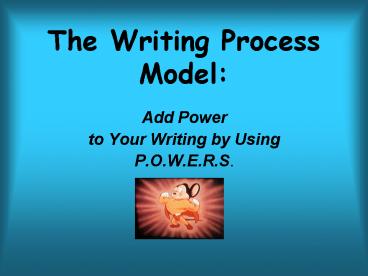The Writing Process Model: PowerPoint PPT Presentation
1 / 11
Title: The Writing Process Model:
1
The Writing Process Model
- Add Power
- to Your Writing by Using
- P.O.W.E.R.S.
2
Why Use a Model for Writing?
- Writing is a difficult task for most people.
Sitting down in front that blank piece of paper
or computer screen and being expected to write an
assignment can be intimidating even for
accomplished writers. - By learning the six steps of the writing process,
our job as a writer becomes easier and more
manageable as the writing task is broken down
into a series of steps.
3
Six Steps in the Writing Process
- Prewrite
- Organize
- Write
- Edit
- Revise
- Share
4
Prewriting
- In this stage, the writer is looking to generate
ideas. - What are some strategies to find ideas?
- Brainstorming-excellent when you need to find
ideas fast. Say ANYTHING that comes to mind.
This is a way to overcome the problem My mind is
blank. There are no wrong ideas! - Free-writing-Much like brainstorming. Write down
anything that comes to mind for a set period of
time (e.g. 5 minutes.) - Make lists about what you know about your topic.
5
More Prewriting
- Another strategy is to ask your self the
following questions about your topic - Who did it?
- What happened?
- When did it happen?
- Where did it happen?
- Why did it happen?
- How did it happen?
6
Organize
- Look for connections between your ideas generated
in the Prewriting step. - Link your ideas together to form an introductory
paragraph that contains your thesis (argument)
for what you are writing about. - Remember Your introductory paragraph is the
readers roadmap to what you will be writing
about.
7
Write
- This stage is also referred to as drafting.
- This is for you, the writer, to find out what you
know about your topic. - Dont worry about spelling or grammar at this
point, just get your ideas down on paper. - Tell the reader where your paragraphs are going
by using topic sentences to introduce each
paragraph - The conclusion should sum up your argument, not
introduce any new information
8
Edit
- Use the spell-checker on your word-processing
program. Caution spell-check wont find every
spelling or grammar error. - Read your essay out loud-You can often hear
mistakes that you dont see when you are
re-reading your paper. - Have someone else look over your paper
- Read your essay backwards to catch errors.
9
Revise
- Ask these questions Are all sections of my
writing clear? If someone who didnt know
anything about my topic read my paper, would they
be able to follow it? - Does your introductory paragraph still agree with
what youve written? Sometimes ideas about topics
change as you are writing about them. - Dont be afraid to do a major overhaul at this
point. If it doesnt work-GET RID OF IT!
10
Share
- Also known as publish.
- This is the final, polished version of your
paper. - You can share your writing in a variety of ways
with your teacher, a friend, on the Web, through
a letter to the editor, etc. - The whole purpose of writing is to let others
know what YOU know!
11
A Final Note
- Although the model presented today as being in a
linear form, writers are free to move from one
stage to another and back again as needed.

